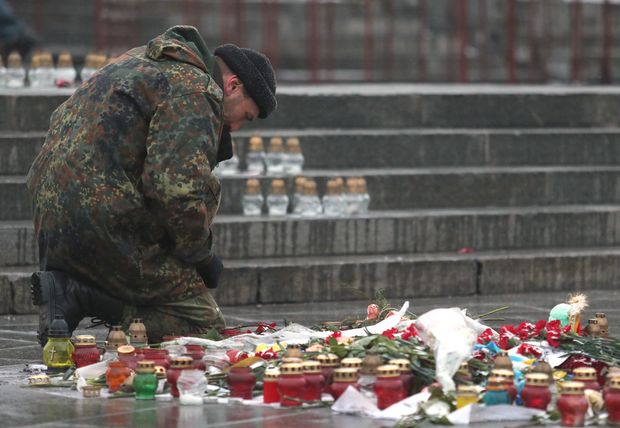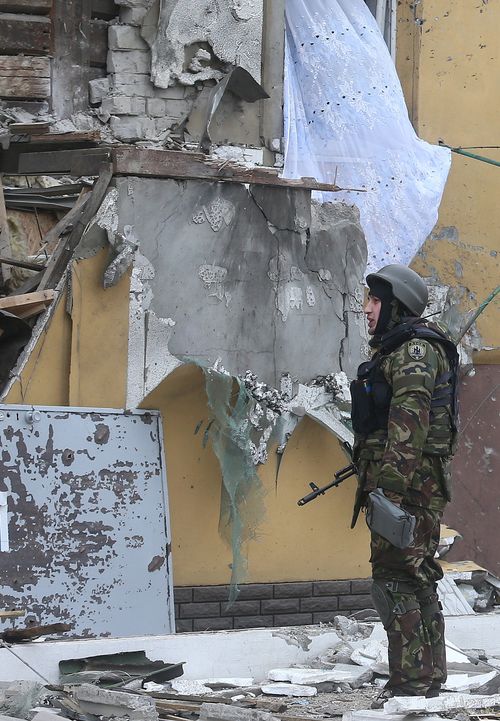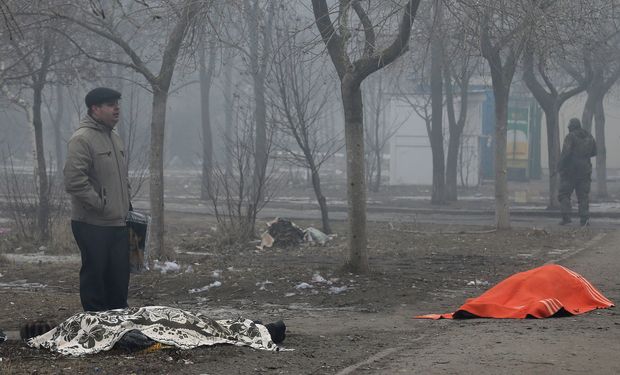The Minsk protocols have been blown to bits in Mariupol
The Ukrainian military responded in force to the Donbas attack. Will the parliament match the soldiers’ effort with its own?
War and peace in Mariupol
The Day’s journalists report on the situation in the wake of the tragedy in the “city of metallurgists”
JANUARY 22. FIRE
Getting to Mariupol, despite it being relatively quiet in the area on that day, was not easy. The train stopped in Zaporizhia oblast, because the militants blew up a railway bridge there on January 20. The “fast” train took us... 18 hours to get there. Nobody, not even the train conductor, knew where the last stop would be. Finally, we got off the train in Berdiansk. The usual chatter and bustle were interrupted by the terrible news of the Donetsk trolley stop attack. According to various sources, the number of victims ranged from 8 to 13. Mizzle and fog that surrounded us only exacerbated confusion and exasperation.
A large Mariupol-bound bus stood near the station. It was donated by a local official, and a number of regional journalists filmed this scene. The bus quickly filled with people, and we went off. We passed four checkpoints quite easily, for only one of them had a man in balaclava perfunctorily browsing through passports of passengers, and others just had short talks with the driver.

THE SHELLING HAS KNOCKED OUT WINDOWPANES IN MANY HOUSES. BROKEN GLASS RAINED EVERYWHERE FOR HOURS. SOON ENOUGH, ACTIVISTS STARTED BRINGING FILM FOR PEOPLE TO COVER HOLES IN THE WINDOWS
On the road, trucks with humanitarian aid from the Ukrainian government overtook our bus. Six truckloads of vegetables, fruits, and canned food were accompanied by two police cars.
It took us an hour and a half to get to Mariupol. Streets were largely deserted. That evening, a Day of Unity rally took place at the bridge near the Azovstal plant. The bridge connects the left and right banks of Mariupol, and serves as a symbol of unity. Many people came there with posters “I am Donetsk.” Most speakers at the event discussed the deadly attacks in Volnovakha on January 13 and in Donetsk on January 22.
The air was heavy with the smell of Azovstal, tinged with a bit of burnt oil, as the activists lit torches. “Some say that torches are an attribute of the fascist movement. I totally disagree. All people present here see fire as a symbol of purity and goodness,” female member of Mariupol’s Self-Defense, going by callsign Lysytsia, told us. “A year ago, the Ukrainian government did not pay attention to the cities of Donetsk region, to the need to promote patriotism here. It seems that nobody cared about it. Due to the current circumstances, all have remembered that Ukrainians live in Mariupol, too. In fact the city has changed dramatically over the past six months. People appreciate living in Ukraine now.”

A SOLDIER OF THE AZOV REGIMENT STANDS NEAR A HOUSE SMASHED BY A SHELL. THE REGIMENT’S SOLDIERS WERE AMONG THE FIRST TO ARRIVE TO THE SCENE AND KEEP ORDER THERE
The rally was not that numerous, gathering up to 200 participants. After a memorial service for the fallen Ukrainian soldiers, the activists marched down the bridge. As they went, they tied blue-and-yellow ribbons to the bridge, to be then sent to Lviv as a symbol of unity. In general, the most popular slogans were “One, united, unified Ukraine!” and “East and West together!”
“Western Ukrainians understand the situation in the Donbas, help us, and it is invaluable,” the event’s co-organizer Anzhela remarked. “We want to explain to the world that Mariupol is an outpost of Ukraine, and the future of the Donbas depends on us.”
JANUARY 23. WATER
Children went to school, workers went to their plants, those with free time on their hands spent it in cafes. Mariupol lived seemingly normal peaceful life. However, an abandoned school on the left bank of the city serves as the base camp and training ground of the Azov regiment. They have the city’s Self-Defense to help them, including ordinary young people who stand ready to assist law enforcement in the hour of need. Pavements and walls of buildings are covered with inscriptions “Shelter” and arrows that point toward the basements.
Misty and gray sky of the winter Mariupol was diluted by blue-and-yellow flags. We chatted with the local resident Oleksii Mykhailiuk. “Many people in Mariupol believe that the fascists have come to power in Kyiv. The people speak as if they are intoxicated. However, nobody can transform another person until they understand by themselves what the reality is,” Mykhailiuk stated.

The twilight was coming, and we went down to the Sea of Azov shore. We entered a low-rise neighborhood, a few streets of cracked houses. Some completely neglected, dilapidated buildings leaned to the water. The sea had frozen and gone into hibernation. Streets were almost totally deserted as the city went to sleep. It was at this time that coordinator of the Kyiv-1 battalion, MP Yevhen Deidei posted on Facebook the fake news that the militants launched a tank assault on Mariupol. Deidei’s sources are still unknown, and the National Security and Defense Council denied this information soon afterwards.
JANUARY 24. IRON
It was Saturday morning. The Central Market saw crowds forming as people bought products and talked, not hurrying anywhere. It was a typical weekend day. We went to the “New Mariupol” NGO’s office. They raise aid for Ukrainian military and the poor as well as organize patriotic events. We suddenly felt a few shocks, as if heavy vehicles were going down the road. On looking back, we saw an empty street with almost zero cars.
We were already at the volunteer center when we read the news about the shelling of Skhidny residential area on the left bank of the city. We tried to call a taxi to no avail, as no one wanted to go there. A driver arrived in a quarter of an hour. It turned out that his niece lived in Skhidny and failed to respond to his phone calls, so the taxi driver had to check on his relative.

DOCTORS AND VOLUNTEERS PROVIDED TIMELY AID TO THE WOUNDED AND CALMED DOWN RESIDENTS OF SKHIDNY NEIGHBORHOOD
Soon, we saw some ambulances that evacuated the wounded. Police and soldiers of the Azov regiment were already at the scene. The bodies of the shelling’s victims lay on the ground. The orderlies in bloodied gloves helped the wounded. The smell of burned matter was insanely intense. Sounds of broken glass went out non-stop, as broken windowpanes fell from the buildings. Experts looked for unexploded shells. Shards of Grad shells were on the pavement, on lawns, in the center of the playground. The police calmed down provocateurs, alarmists, small-time looters, and people who wanted to take a selfie with a burned-out car in the background.
“These shells were fired from the direction of Novoazovsk. Ask my daughter for confirmation. Ukrainian troops did not fire on Mariupol, it was the Russians who did it,” Serhii Minich said promptly. His house had the windows knocked out. He was at that time in the market along with his daughter. When they heard the explosions, they fell to the floor and covered their heads with their hands. “If not for two cars next to us, debris would have killed us, as two shells exploded behind us,” Minich almost shouted.
Precise data on the scale of the tragedy would be announced the next day. According to the Interior Ministry of Ukraine’s Chief Directorate in Donetsk region, the shelling killed 30 people, and 95 people were injured. As much as 79 structures were damaged, including 37 private houses, 22 flats, 2 markets, 8 shops, a post office, 2 banks, a pharmacy, a cafe, and a car repair station. The Donetsk police reported also that the attack was launched from the so-called Donetsk People’s Republic-occupied villages of Sakhanka and Lebedynske, Novoazovsk raion.
Mariupol suddenly came to life, defying numerous deaths. Skhidny neighborhood had a heated facility opened soon, allowing inhabitants of the destroyed buildings to relax and eat. Townspeople are donating warm clothes to the victims and film to cover their broken windows. “Members of our organization go to their homes and help to cover the windows with film, clean up their flats. The volunteers also dismantle blockages and tow away burnt-out cars,” the New Mariupol’s activist Valeria listed their activities. “It is business as usual for us. There is no panic for Mariupol has long been a frontline city.”
A few hours after the shelling, the city center housed a memorial rally. It was initially intended to honor those who died in Donetsk on January 22, but following the morning events in Mariupol, the event’s participants prayed for all the victims of this war. “The active community of Mariupol came to remember all those who died and pray for peace. I want to live in a peaceful city. People are nervous, confused, but many are indifferent. Just indifferent,” the rally’s participant Maryna Siomina said sobbing.
Another participant, looking a bit too quiet in the light of the recent events, went by his first name Oleksii and swung a big flag of Ukraine about. “My daughter lives on the left bank of the city. A kindergarten nearby was hit by shells and had its windows broken. My son-in-law drove my daughter to live with me in a low-rise neighborhood. My son, meanwhile, is fighting for Ukraine and defending Mariupol. I am quite calm, because I know that we will not surrender the city. Should the need arise, I will defend Mariupol myself,” Oleksii said.
The city’s residents have joined their efforts and are getting those affected out of trouble. There is that stubborn feeling that Mariupol will overcome all troubles, for the city’s defenders are people with iron nerves and kind hearts.
P.S. As we went back to Kyiv, we shared the train compartment with “cyborgs.” The soldiers talked a lot about frontline life and said that the most difficult task was to stay human at war. We have stayed this way so far, and this is our greatest victory.






